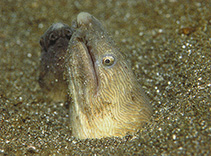| Family: |
Ophichthidae (Snake eels), subfamily: Ophichthinae |
| Max. size: |
108 cm TL (male/unsexed) |
| Environment: |
reef-associated; freshwater; brackish; marine; depth range 1 - 20 m, anadromous |
| Distribution: |
Indo-Pacific: Red Sea and East Africa to French Polynesia, north to the Ogasawara Islands, south to Australia. |
| Diagnosis: |
Dorsal spines (total): 0-0; Anal spines: 0-0; Vertebrae: 152-163. Teeth molariform, multiserial on jaws, intermaxillary and vomer; dorsal fin with broad dark edge (Ref. 37816). Dorsal fin beginning above pectoral fin (Ref. 12693). Body snake-like, cylindrical, compressed only along extreme tail tip; anterior nostril tubular, posterior nostril along lower edge of lip; median fins not continuous posteriorly; extreme tip of tail stiff and finless; dorsal fin origin over front to middle portion of pectoral fins; lateral line inconspicuous (Ref. 4832). Variable from grey to black or brown. Large individuals have wrinkled skin (Ref. 48635).
Description: Characterized by head length 8.5-10 in TL; depth of body about 22-36 (Ref. 90102). |
| Biology: |
Occurs in lagoons and estuaries, entering freshwater (Ref. 12693). Often in tidal channels where loose groups congregate, and usually seen with just the head exposed (Ref. 48635). Caught most often in tidal areas and estuaries (Ref. 12693). Caught in bag nets and similar gear. Marketed fresh (Ref. 7050). |
| IUCN Red List Status: |
Least Concern (LC); Date assessed: 29 November 2019 Ref. (130435)
|
| Threat to humans: |
harmless |
Source and more info: www.fishbase.org. For personal, classroom, and other internal use only. Not for publication.

